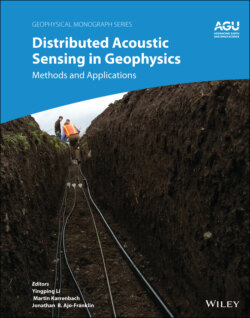Читать книгу Distributed Acoustic Sensing in Geophysics - Группа авторов - Страница 20
1.1.4. DAS Dynamic Range Algorithms
ОглавлениеAn acoustic algorithm (Equation 1.15) transforms the DAS intensity signal into a phase shift proportional to fiber elongation value; a question then is how large can this phase shift be? An algorithm based on such ambiguous function as ATAN(x) can give a result only inside a limited region. The classic approach to recover large phase changes is unwrapping: stitching together two consecutive points t and t + Δt from different branches of signal (Itoh, 1982):
(1.17)
This unwrapping, or phase tracking, concept works only if the phase difference is inside two quadrants:
(1.18)
Equation 1.17 makes it possible to measure significant fiber elongation, much longer than the wavelength. If the sampling rate FS = 1/Δt is higher than the acoustic frequency F, a larger acoustic amplitude can be integrated A0FS/2F ≈ 68μ over time for F = 50Hz and FS = 50kHz. Moreover, even this value has improved, and Equation 1.18 gives an idea of this. If the phase is a smooth function, we can differentiate in time Φ(t) before unwrapping. Then, the first differential linear term is removed, and condition becomes more relaxed:
(1.19)
So, the second order tracking algorithm can be obtained by differentiating the signal before unwrapping:
(1.20)
Equation 1.20 has an analog in classical optics, where, instead of the wavefront phase gradient, the wrapped curvature of the wavefront can be unwrapped to increase the dynamic range (Servin et al., 2017). A comparison of these algorithms is presented in Figure 1.8 using modeling for a harmonic signal with a linearly increasing amplitude. It is visible that both algorithms can recover a significant phase range, but the second order tracking algorithm can deliver in excess of a 10 times larger dynamic range.
Theoretically, even higher order algorithms can be designed by repeating this process using higher order derivatives, but they are noisier as more points are involved in the calculation—as can be seen by comparing Equations 1.18 and 1.19. From a practical point of view, the proposed 1D (in time) unwrapping algorithms are error‐free and simple enough to be implemented in real time. Potentially, noise immunity can be improved by transition to 2D (in time and distance) unwrapping, similar to that used in a synthetic aperture radar system (Ghiglia & Pritt, 1998). This solution can extract as much information about the phase as possible, but it is difficult to implement without post‐processing.
Figure 1.8 Comparison of first and second order tracking algorithms for DAS.
